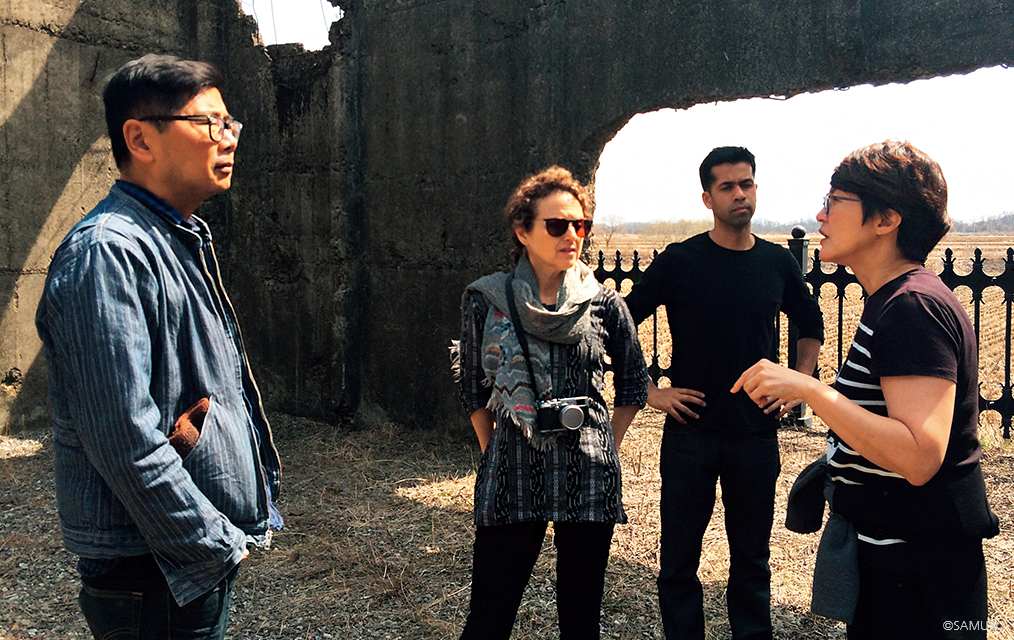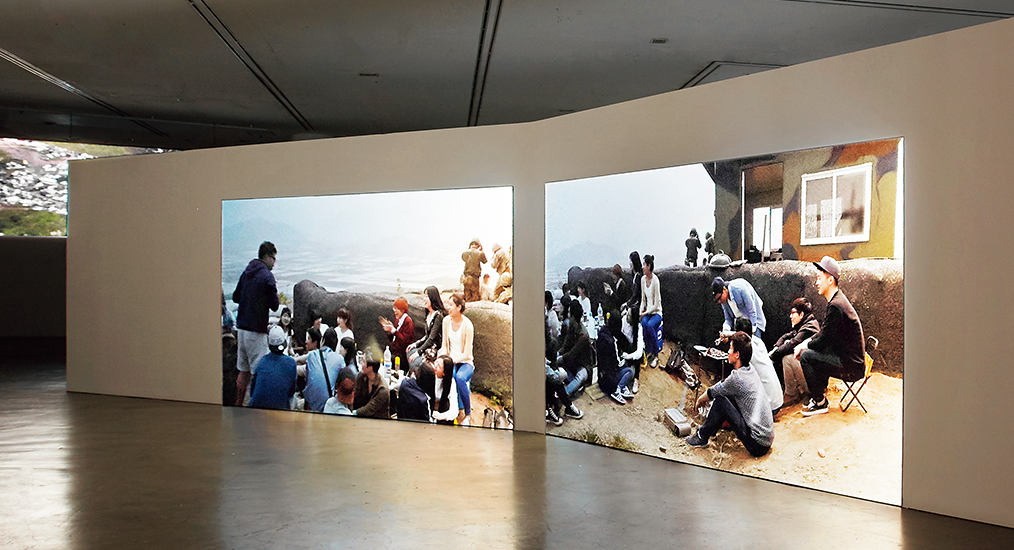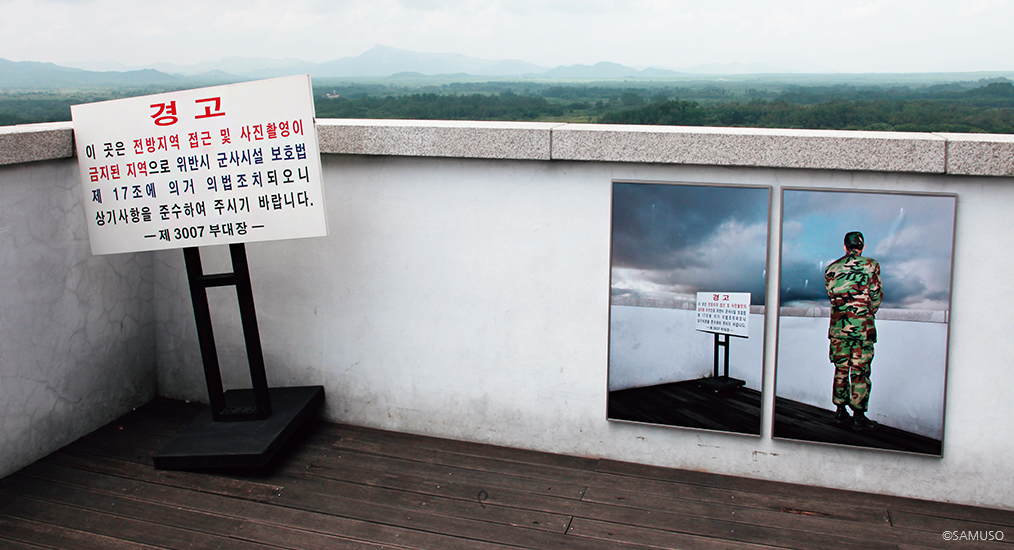The Real DMZ Project is a contemporary art project that seeks to interpret andthe multi-ed significance of the DMZ and its adjacent areas. Beginningwith a site-specific exhibition held in 2012 along the Cheorwon Security Tour Course inthe central frontline area of Gangwon Province, the project has been expanded everyyear to include a variety of experimental exhibitions and academic forums.
“Claims of Victory” (2015) by Magnus Bärtås is a videoinstallation highlighting the different ways the KoreanWar is commemorated at the respective war museumsin Pyongyang and Seoul.
The DMZ is a contradictory space.On either side of the military bufferzone designed to serve as a defacto border dividing the Korean Peninsula,the two Koreas have maintained a frailtruce, still aiming their weapons at eachother. Left untouched for decades, the areahas a clean ecosystem featuring rare speciesof animals and plants, but it is also themost heavily fortified border in the world,where a military contingency could occur atany time. In the vicinity, however, ordinarypeople go about their daily lives tilling theirfields in the South’s northernmost villages,located within the civilian control zone justbelow the southern limit line of the DMZ.This contradictory nature of the DMZ, ratherthan its political and military implications,is the focus of the Real DMZ Project.
Kim Sun-jung, curator and representativeof SAMUSO: Space for ContemporaryArt, who conceived and organized the project,explained its intent: “The parties tothe armistice agreement of 1953 were theUnited States, the United Nations, NorthKorea, and China; South Korea was excluded.Reflecting on the past when we were sopassive in our own affairs, I hoped this projectwould help us take the initiative in reinterpretingthe significance of the DMZ.”
I met Kim to discuss the DMZ as perceivedby the participating artists.
The Division of Korea Revisited
Ko Mi-seok Why the DMZ? What madeyou choose this place of conflict as thevenue for an art project?Kim Sun-jung In 2008, I organized anexhibition of the Japanese artist TatsuoMiyajima on the theme of this border. Theevent involved taking photographs of peoplewhose bodies were painted with thenumbers 3 and 8 to signify the 38th parallelnorth, which forms the border betweenSouth and North Korea. The photos weretaken against the backdrop of ImjingakPavilion in Paju, Taepung Observatory inYeoncheon, and other spots in the borderareas. While researching relevant socialissues in planning the exhibition, I realized,with much remorse, that although I amKorean I knew hardly anything about theDMZ and had taken no interest in it.
Later, I planned a 10-year project withthe aim of archiving records and artworkson the DMZ. The participation of bothdomestic and foreign artists was taken intoaccount from the beginning, and our direction in research and planning was determinedaccordingly. The scope of the projecthas been extended to include a broaderrange of topics, such as varied notions ofthe Military Demarcation Line, sociopoliticalconditions resulting from the division,and entailing environmental issues. A complementaryevent to the on-site exhibitionis held at Art Sonje Center in Seoul, whichincludes performances, talks with the artists,workshops, and other activities.
The project’s main venue is Cheorwonin Gangwon Province. This central inlandcounty briefly fell under the jurisdiction ofthe Soviet Military Administration when theborderline was drawn along the 38th parallel,soon after Korea’s liberation from Japanesecolonial rule in 1945. Since the countystraddles the inter-Korean border, with onethird of the DMZ stretching across it, itssouthern part is the territory of the Republicof Korea, and its northern part the DemocraticPeople’s Republic of Korea. During theKorean War, Cheorwon was a vital strategicarea for securing the central front, and alsothe site of one of the fiercest battles, knownas the Iron Triangle. Located in the heart ofthe Korean Peninsula, it had prospered asa transport and logistics hub before it waspractically devastated during the war.
Interaction with the Locals
Ko What has changed over the yearssince the start of the project?Kim In the first year, the exhibitionwas mostly held in places near the borderwith rather limited accessibility, suchas a section along the Cheorwon SecurityTour Course or deep inside the InfiltrationTunnel, and ran for a shorter period oftime. Unlike most regular exhibitions thatare based on existing works, the projecthas featured mostly new works producedspecifically for our exhibition. To makethis possible, participating artists need totake some time to learn about the DMZ.It seemed a shame to close the exhibitionso quickly when the works had takenso long to . So, we have modified theevent and eventually transformed it from anexhibition held in a restricted area, whichrequired authorized entry, into a local activityopen to everyone. An art project thatreceives financial support from the localgovernment, it should have been moreaccessible to the local community. So, in2015, we moved the venue to the town ofDongsong, which is readily accessible forlocals and soldiers on leave.

Curator Kim Sun-jung (far right) talks with contributing artists for the Real DMZ Project onthe site of an icehouse from the Japanese colonial period, which was destroyed during theKorean War save for part of the walls.
Ko WIt seems the change was intendedto enlarge the scope of the project fromthe border itself to the everyday lives of thepeople living in the border areas.Kim As a public art project in a publicplace, we are concerned with continuity.That’s why we don’t treat it as a one-timeevent, but seek to get closer to the residentsevery year. “The Real DMZ Project2015: Lived Time of Dongsong” took placeat various sites around the town, such asthe marketplace, Catholic church, bus terminal,and empty buildings. Moving fromthe restricted area near the civilian controlline out to the town with commercial andcultural facilities, we came into closer contactwith the residents.
Ko Is the residency program at a villagein the civilian control zone an attemptalong the same lines?Kim The Yangji-ri Residency waslaunched in 2014 in the village of the samename. The program encourages artists andscholars from Korea and abroad to live andwork on site for the exhibition. A desertedhouse in the village was renovated for thispurpose, and 10 or so artists have participatedin the program so far. A small villaged in the 1970s for propaganda targetedat North Koreans living on the otherside of the border, Yangji-ri now has about130 residents in 75 households. At first, thevillagers and the artists were on somewhatawkward terms with each other, but they’vegotten so close that some residents arehelping the artists to grow their own food.An Argentine artist, who likes to hold barbecueswith his neighbors, is filming themfor his video work.
Cellist Lee Ok-kyung offers an impromptu performance “Broken Sky” in an abandonedrice mill in Yangji-ri, a village in the civilian control zone, during the Real DMZ Project 2014.
Differing Perspectives of Outsidersand Insiders
Ko It seems that the project is trying toachieve both regional originality and globaluniversality while dealing with Korea’sspecial situation.Kim As in the case of the DMZ thatdivides the two Koreas, the world at largemay share an interest in the issue of borderlinesformed by the complicated workingsof armed conflicts and internationalcircumstances. Until its unification in 1975,Vietnam was divided into North and Southby a DMZ running along the 17th parallelnorth. Germany was also divided intoEast and West after World War II beforethe border was erased with the fall of theBerlin Wall. The DMZ between Syria andIsrael and the border between Iraq andKuwait have been installed in accordancewith United Nations Security Council resolutions.Whether physical or psychological,the theme of borders — or anythingdividing land, or people for that matter —is always relevant. With the Cold War farbehind us, this is also apparent in today’sraging conflict over cross-border refugees.Ko Are there any differences in theinterpretations of the DMZ between Koreanand foreign artists?Kim Korean artists who received anticommunismeducation in school tend tomake a conscious effort to see familiarsituations from a new angle. Artists fromother countries understand the DMZ ontheir own terms, approaching it from muchwider perspectives. As they share an interestin such concepts as state, nation, ideology,and border, the artists try to find a wayto combine the DMZ with topics of their owninterests. They are also keen on identifyingfeatures unique to Korea — such as themilitary culture. You can’t grasp the wholepicture when you see it only from the inside.Placed between cold war and hot peace,the DMZ needs to be seen from the outsideor from international perspectives in orderfor its complexity to be fully understood.

“Ice Cream Hill” (2014–2015), a video installation by Aernout Mik, portrays the divide andconflict between South and North Korea using the story of a group of young people on anexcursion to Sapseul Peak near the DMZ that is ruined by tension.
Noteworthy Works
Ko Could you introduce some of theworks that you found to be especiallyimpressive?Kim “Ice Cream Hill” by Aernout Mikfrom the Netherlands is a video workcommissioned for the project. In the film,which took a full year to produce, the icecream is a metaphor for a certain mountainthat looked as if it were melting underheavy artillery fire during the war. The work shows how this place with a beautiful hillhas been charged with grave historicalmeaning.
Magnus Bärtås from Sweden has beenapplauded for “Claims of Victory,” a videoinstallation that combines footage takenin two museums — the War Memorial ofKorea in Seoul and the Victorious FatherlandLiberation War Museum in Pyongyang— to illustrate how the conflict between thetwo Koreas is portrayed in the respectivecountries. While the museum in Pyongyangshowcases actual relics from the KoreanWar, such as real tanks and jeeps, againsta grand backdrop painted by 40 artists, themuseum in Seoul features dioramas usingspecial effects that resemble computergames. The artist highlights the contrastby projecting the distinctly different videoimages onto two adjacent screens.
In addition, the German novelist IngoNiermann wrote 11 scenarios for a unifiedKorea, entitled “Solution 264-274: DrillNation,” based on his visits to both Koreas.He gave a public recital of the first chapterof the book, which he had started writingduring the 2014 project to publish in 2015.I especially remember what he said in aninterview: “I got the impression that SouthKorea had developed the DMZ as a wartourism product, while North Korea hadturned the entire country into a war themepark.”Ko I guess that most foreign artistshad seen the DMZ only in the mediabefore actually visiting the area. Whenthey arrived at the DMZ, what caught theirattention?Kim The artists looked at it in their ownways. Some were attracted to the naturalenvironment of the DMZ as a valuable ecosystem.Others wanted to convey an envisionedfuture in their works, imagining, say,a house where South and North Koreanslive together, or an installation built throughtheir collaborative work.

The photo installation “To Survive vs. Once Arrived”(2012) by Noh Sun-tag includes a set of photographstaken from the rooftop of the Peace Observatory inCheorwon, which commands a panoramic view of thePyonggang Plateau in North Korea. The photo of a signwarning against taking photos and that of the rear viewof a soldier are on display on the same spot where theywere taken. The photographer says, “In the South, theborder area has become a popular tourist attractionamong Koreans and foreigners alike. What would bethe duty of those who visit this peculiar place? It wouldbe to see, to take pictures.”
“I got the impression that South Korea had developed the DMZ as a war tourism product, while North Koreahad turned the entire country into a war theme park.” — Ingo Niermann (novelist, participating artist)
Ko Could you describe some of theworks by Korean artists as well?Kim “Korean artists encouraged viewersto ponder on our past history and currentlives, and the coexistence of tensionand everyday life. Lim Min-ouk presentedan archive of records on 300 people whowere allegedly massacred on the site of theWaterworks Bureau in Cheorwon after thewar. Koo Jeong-a d an installationon the Peace Plaza using basalt, a characteristicelement of land formed by lava.Former photo journalist Noh Sun-tag presentedary-style photographs,including images of tourists visiting theinfiltration tunnels in the DMZ, taken frombehind. But nothing beats seeing the worksfor yourself. I hope more people will cometo the DMZ to see, feel, and think about howand why this project deals with regionalproblems on an international level.
Through the DMZ project, Kim Sun-junghas developed a channel for collaborationof visual arts, architecture, music, humanities,and social studies. This year, the regularexhibition will be skipped to prepare fornext year’s “Pavilion Project,” which willfacilitate permanent preservation of theworks. Kim is also determined to keep theproject going past its initial 10-year target.
As a research platform to enhanceunderstanding of Korea’s modern history,the Real DMZ Project ultimately aspires tooffer a vision for world peace and coexistenceby integrating local and global perspectives.If it succeeds in these goals, theproject will provide us with an opportunityto reflect on not only the physical borderlineof the DMZ but also the invisible, psychologicalbarriers in our own minds.
Koh Mi-seokEditorial Writer, The Dong-a Ilbo